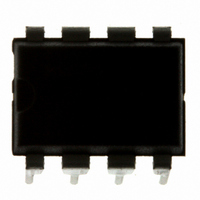MC9S08QG4MPAE Freescale Semiconductor, MC9S08QG4MPAE Datasheet - Page 247

MC9S08QG4MPAE
Manufacturer Part Number
MC9S08QG4MPAE
Description
IC MCU 4K FLASH 8-PDIP
Manufacturer
Freescale Semiconductor
Series
HCS08r
Datasheet
1.MC9S08QG8CDTER.pdf
(314 pages)
Specifications of MC9S08QG4MPAE
Core Processor
HCS08
Core Size
8-Bit
Speed
20MHz
Connectivity
I²C, SCI, SPI
Peripherals
LVD, POR, PWM, WDT
Number Of I /o
4
Program Memory Size
4KB (4K x 8)
Program Memory Type
FLASH
Ram Size
256 x 8
Voltage - Supply (vcc/vdd)
1.8 V ~ 3.6 V
Data Converters
A/D 4x10b
Oscillator Type
Internal
Operating Temperature
-40°C ~ 125°C
Package / Case
8-DIP (0.300", 7.62mm)
Controller Family/series
HCS08
No. Of I/o's
6
Ram Memory Size
256Byte
Cpu Speed
20MHz
No. Of Timers
2
Embedded Interface Type
I2C, SCI, SPI
Rohs Compliant
Yes
Processor Series
S08QG
Core
HCS08
Data Bus Width
8 bit
Data Ram Size
256 B
Interface Type
I2C, SCI, SPI
Maximum Clock Frequency
20 MHz
Number Of Programmable I/os
12
Number Of Timers
1
Maximum Operating Temperature
+ 125 C
Mounting Style
Through Hole
3rd Party Development Tools
EWS08
Development Tools By Supplier
DEMO9S08QG8E
Minimum Operating Temperature
- 40 C
On-chip Adc
10 bit, 8 Channel
Lead Free Status / RoHS Status
Lead free / RoHS Compliant
Eeprom Size
-
Lead Free Status / Rohs Status
Details
- Current page: 247 of 314
- Download datasheet (6Mb)
Typically, a relatively simple interface pod is used to translate commands from a host computer into
commands for the custom serial interface to the single-wire background debug system. Depending on the
development tool vendor, this interface pod may use a standard RS-232 serial port, a parallel printer port,
or some other type of communications such as a universal serial bus (USB) to communicate between the
host PC and the pod. The pod typically connects to the target system with ground, the BKGD pin, RESET,
and sometimes V
which is useful to regain control of a lost target system or to control startup of a target system before the
on-chip nonvolatile memory has been programmed. Sometimes V
power from the target system to avoid the need for a separate power supply. However, if the pod is powered
separately, it can be connected to a running target system without forcing a target system reset or otherwise
disturbing the running application program.
17.2.1
BKGD is the single-wire background debug interface pin. The primary function of this pin is for
bidirectional serial communication of active background mode commands and data. During reset, this pin
is used to select between starting in active background mode or starting the user’s application program.
This pin is also used to request a timed sync response pulse to allow a host development tool to determine
the correct clock frequency for background debug serial communications.
BDC serial communications use a custom serial protocol first introduced on the M68HC12 Family of
microcontrollers. This protocol assumes the host knows the communication clock rate that is determined
by the target BDC clock rate. All communication is initiated and controlled by the host that drives a
high-to-low edge to signal the beginning of each bit time. Commands and data are sent most significant
bit first (MSB first). For a detailed description of the communications protocol, refer to
“Communication
If a host is attempting to communicate with a target MCU that has an unknown BDC clock rate, a SYNC
command may be sent to the target MCU to request a timed sync response signal from which the host can
determine the correct communication speed.
BKGD is a pseudo-open-drain pin and there is an on-chip pullup so no external pullup resistor is required.
Unlike typical open-drain pins, the external RC time constant on this pin, which is influenced by external
capacitance, plays almost no role in signal rise time. The custom protocol provides for brief, actively
Freescale Semiconductor
•
read or written, and allow the user to trace one user instruction at a time, or GO to the user program
from active background mode.
Non-intrusive commands can be executed at any time even while the user’s program is running.
Non-intrusive commands allow a user to read or write MCU memory locations or access status and
control registers within the background debug controller.
BKGD Pin Description
DD
Details.”
. An open-drain connection to reset allows the host to force a target system reset,
MC9S08QG8 and MC9S08QG4 Data Sheet, Rev. 5
Figure 17-1. BDM Tool Connector
NO CONNECT 3
NO CONNECT 5
BKGD
1
2
4
6
GND
RESET
V
DD
DD
can be used to allow the pod to use
Development Support
Section 17.2.2,
245
Related parts for MC9S08QG4MPAE
Image
Part Number
Description
Manufacturer
Datasheet
Request
R
Part Number:
Description:
Manufacturer:
Freescale Semiconductor, Inc
Datasheet:
Part Number:
Description:
Manufacturer:
Freescale Semiconductor, Inc
Datasheet:
Part Number:
Description:
Manufacturer:
Freescale Semiconductor, Inc
Datasheet:
Part Number:
Description:
Manufacturer:
Freescale Semiconductor, Inc
Datasheet:
Part Number:
Description:
Manufacturer:
Freescale Semiconductor, Inc
Datasheet:
Part Number:
Description:
Manufacturer:
Freescale Semiconductor, Inc
Datasheet:
Part Number:
Description:
Manufacturer:
Freescale Semiconductor, Inc
Datasheet:
Part Number:
Description:
Manufacturer:
Freescale Semiconductor, Inc
Datasheet:
Part Number:
Description:
Manufacturer:
Freescale Semiconductor, Inc
Datasheet:
Part Number:
Description:
Manufacturer:
Freescale Semiconductor, Inc
Datasheet:
Part Number:
Description:
Manufacturer:
Freescale Semiconductor, Inc
Datasheet:
Part Number:
Description:
Manufacturer:
Freescale Semiconductor, Inc
Datasheet:
Part Number:
Description:
Manufacturer:
Freescale Semiconductor, Inc
Datasheet:
Part Number:
Description:
Manufacturer:
Freescale Semiconductor, Inc
Datasheet:
Part Number:
Description:
Manufacturer:
Freescale Semiconductor, Inc
Datasheet:










